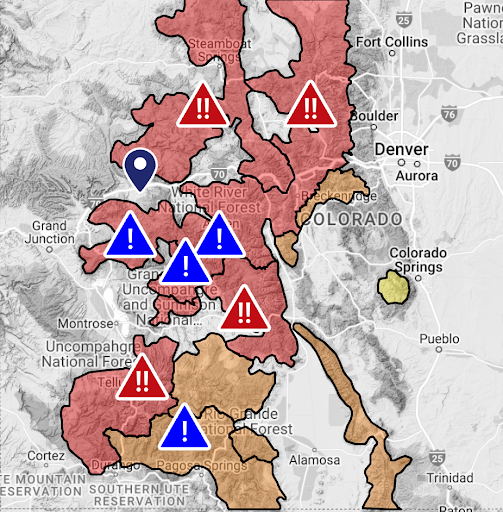CAIC Alerts
The CAIC issues avalanche danger ratings based on the North American Avalanche Danger Scale. This scale contains five levels from LOW danger (Level 1) to EXTREME danger (Level 5). During certain avalanche conditions, we may issue one of the following alerts in addition to the danger rating:
- Avalanche Watch
- Avalanche Warning
- Special Avalanche Advisory
Each of these alerts has a different purpose, and we issue them to catch your attention for different reasons. When issued, an alert is clearly displayed on the homepage forecast map and as headline banners in the backcountry avalanche forecast.



Avalanche Watches and Warnings are issued based solely on the current or expected avalanche hazard. We issue them when the avalanche hazard is or will be HIGH (Level 4) or EXTREME (Level 5) at two or more elevation bands.
In comparison, Special Avalanche Advisories are based on concerns of an increased safety risk due to potentially dangerous conditions for many people. For example, the CAIC could issue an SAA if a big storm is going to roll through during a holiday weekend. We might also issue an SSA if large human-triggered avalanches are likely over a weekend with deep powder and bluebird conditions. In other words, we consider the avalanche conditions and the number of people that we expect in the backcountry. We’ll issue a Special Avalanche Advisory when we are worried that you have an increased chance of getting in an avalanche accident, but the avalanche danger isn’t going to be HIGH or EXTREME.

Avalanche Watch
An Avalanche Watch indicates that the avalanche danger is expected to reach HIGH or EXTREME at two or more elevation bands within the next 36 hours. This indicates that we expect to issue an Avalanche Warning.
Our goal is to issue an Avalanche Watch before an Avalanche Warning to provide notice of very dangerous conditions. Although this is the goal, at times we may issue an Avalanche Warning without issuing a Watch. We might also issue an Avalanche Watch and no subsequent Avalanche Warning. Remember, these are forecasts and sometimes the avalanche danger rises rapidly. Other times we expect it to rise, but the storm fizzles and the danger never reaches the criteria for High.
What you should do- Be prepared! Reevaluate your backcountry travel plans for the following day. Consider planning alternate safe routes for multi-day trips should conditions worsen. Check the avalanche forecast at Colorado.gov/avalanche for the latest updates.
Avalanche Warning
An Avalanche Warning means we have very dangerous avalanche conditions. The avalanche danger is HIGH or EXTREME at two or more elevation bands. Large natural avalanches are either happening or are expected to happen during the forecast period. During an Avalanche Warning, human-triggered avalanches are very likely.
What you should do- Take action! Avoid avalanche terrain. If you are traveling in the backcountry during a warning, be aware of your surroundings and avoid crossing underneath avalanche paths. Plan any backcountry outing very carefully to steer clear of avalanche terrain and give avalanche paths a wide berth.
Special Avalanche Advisory (SAA)
A Special Avalanche Advisory means the avalanche danger is not HIGH or EXTREME but we have conditions that pose an increased safety risk. We might issue an advisory to alert you of rapidly changing avalanche conditions or potentially dangerous conditions with many people at risk. For example, we could issue an SAA if a big storm is going to roll through during a holiday weekend. We might also issue an SSA if large, human-triggered avalanches are likely over a weekend with deep powder and bluebird conditions.
What you should do- Exercise caution. Evaluate slopes that are mentioned in the advisory with extra caution. For example, the SAA may talk about Persistent Slab avalanches breaking wider than expected and being touchier than expected on north and northeast-facing slopes. In this situation, you would want to factor in a wider margin for safety while trip planning.
